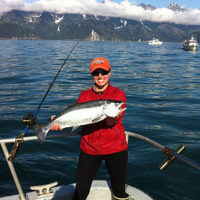The Nushagak River, Bristol Bay, Alaska, supports one of the largest wild sockeye salmon (Oncorhynchus nerka) runs in the state and also supports overlapping runs of chum (O. keta) and Chinook (O. tshawytscha) salmon. Each summer, the Alaska Department of Fish and Game deploys dual-frequency identification sonar (DIDSON) on the river to enumerate salmon to monitor escapement goals; however, salmon behavior and spawning run characteristics at the site are not incorporated into management. We investigated the feasibility of using Nushagak River DIDSON data from 2008-2011 to identify trends in run timing and compare passage rates to local environmental conditions, including tide, light intensity, and water temperature. We also used spatial analysis to examine aggregation behavior of salmon at the DIDSON site at multiple distance scales. Between all four years, run timing only varied within a few days (< 1 week), regardless of water temperature. In 2009 and 2011, more salmon passed upriver during slack and ebb tides than during flood tide. Salmon were never completely spatially random, and distance scales of aggregation behavior were influenced by run period and photo period. When examining all factors together, the interaction between salmon density and run period affected distance at maximum aggregation. This research used hydroacoustics for a multi-level approach to investigating spatiotemporal patterns of Pacific salmon relative to environmental factors during their spawning migration and may help refine in-season monitoring and management of the fishery.
Funding for this work was provided by the Pollock Conservation Cooperative via the Alaska Education Tax Credit Program.
Current Status: Fishery Biologist, National Marine Fisheries Service Alaska Region Habitat Conservation District (Anchorage, AK)

